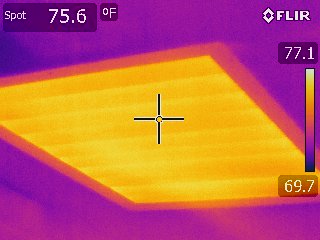Whole House Fans: Keep or Remove?

Whole house fans have been around for years. They have started to gain popularity in recent years again due to their energy savings over A/C systems, but should you keep or remove an existing whole house fan? We run you through the pros and cons of a whole house fan.
What is a whole house fan?
A whole house fan is found in the highest level of a house, commonly in the ceiling that separates the home from the attic, and in the center of the house. The fan is controlled by its own switch and usually run during the coolest part of the day, typically at night or early in the morning. The whole house fan is used to exhaust hot air from the home and pull in the air that is cooler from outside.
What is the ideal climate for a whole house fan?
A dry and cool climate is ideal for a whole house fan. It is perfect for those living in areas that have a large difference in temperature overnight.
What are the advantages of a whole house fan?
Whole house fans are often used in the summer months to save energy. They use roughly 10-15% of the wattage an air conditioner uses making your energy bill much lower.
A whole house fan works extremely quickly. Depending on the size of your whole house fan, it can cool the house in minutes by pushing the warmer air out and allowing cooler air in through the windows.
What are the disadvantages of a whole house fan?
While a whole house fan is known for saving money on the cooling bill, it can possibly lead to a higher heating bill in the winter, especially for older whole house fans. An older house fan is a perfect escape for the air you are paying to heat in the wintertime. When your whole house fan is not used in the summertime, the inefficient louvers provide access for the hot attic air to push into your cooler home.
When the whole house fan is running, the windows should be open to pull in the cooler air, which isn’t ideal for those with allergies. Then after the fan has run, the windows should be closed for the remainder of the day to prevent the warmer air from entering the home. If it's humid outside, like it often is here in Michigan, the outside air may not feel that cool as it brings the humidity into your home.
Whole house fans can be very noisy, especially older models. While strides have been made to improve the noisiness of the fan, it is still one of the top complaints among those who have a whole house fan.
Should I keep my whole house fan?
Unfortunately, there are a variety of variables making it hard to say yes, keep your whole house fan or no, get rid of your whole house fan. At Ecotelligent Homes, we offer three options for a whole house fan. We recommend one of the following after conducting an energy audit to determine the best course of action for your specific home.
REMOVE THE FAN AND DRYWALL OVER THE OPENING IN YOUR CEILING
Removing the whole house fan and drywalling the hole is the most energy-efficient option. Patching the drywall allows for the best air sealing and insulating in the attic space. It also allows for your home's heating and cooling system to effectively and efficiently heat and cool your home.
REPLACE THE FAN WITH A NEW HIGH-EFFICIENCY WHOLE HOUSE FAN
We do understand that some people prefer to use their whole house fan. They are also a great alternative if you do not have an air conditioner. If either of these are true, we would suggest installing a new high-efficiency fan if you have an older model fan. The new high-efficiency fan should have a built-in insulation cover and airtight seal.
INSTALL AN INSULATED AND AIRTIGHT COVER OVER THE EXISTING FAN
If you would prefer to not remove the whole house fan or replace it with an efficient fan, we recommend an insulated and airtight cover over the existing fan. The cover will prevent some, but not all of the air from entering or exiting the home through the whole house fan. You will have to remove the cover to operate the fan and then re-install the cover after each use.
At Ecotelligent Homes, we often suggest removing the whole house fan and drywalling the hole since it is the most energy-efficient solution, but each home is unique so there is not a one size fits all solution. Contact Ecotelligent Homes today to schedule your comprehensive home energy audit to learn more about the best option to improve your whole house fan.

Ecotelligent Homes
Since 2009, more than 3,000 Michigan homeowners have trusted Ecotelligent Homes to make their homes comfortable and efficient. If you want an energy audit, insulation, HVAC, or abatement services, give us a call anytime: (248) 291-7815. Satisfaction guaranteed.
